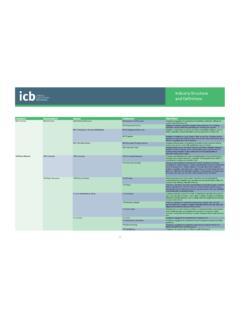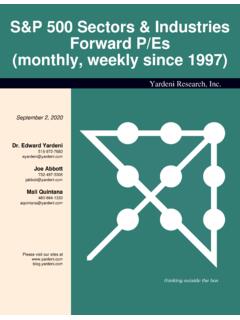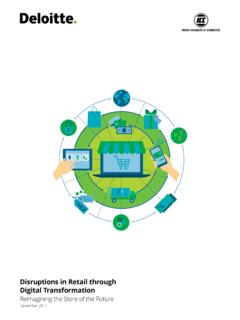Transcription of 2021 retail industry outlook - Deloitte
1 2021 retail industry outlookThe new rules of retail2021 retail industry outlook : The new rules of retail2We just lived through a market-shaping year; roughly 50 retail bankruptcies occurred during a time when others experienced record consumer behavior changed overnight as health and safety concerns suddenly became a purchase driver, and we saw technological adaption in a matter of months that would normally have taken years to occur. This was all brought on by COVID-19, but the effects will be with us even when the pandemic subsides. As a result, there are some new rules for this backdrop, we interviewed 50 retail executives and 15 of our retail subject-matter specialists to address what the retail world may look like when COVID-19 is in our rearview mirror and what that means for retailers as they plan for 2021 and beyond. Will consumers return to a reshaped retail environment? If so, when? Will the pandemic s digital adoption be the new baseline?
2 Or will consumers pent-up demand for interaction and experience drive them to rally around local shops that give them a taste of prepandemic life?It is abundantly clear in our survey that retail subsectors performed very differently during 2020. Grocers, home improvement, and mass merchants benefited from changes in consumer behavior, along with being categorized as essential services. As such, they are aggressively looking to drive revenue growth in 2021. Others, like apparel and department stores, struggled from the onset of the pandemic and are approaching the upcoming year with a higher priority around cost-cutting. Despite these differences, executives agreed, they aren t going to let this crisis go to waste. It may be a once-in-a-lifetime opportunity for organizations to transform their businesses and rewrite the rules of the particular, executives identified four priority areas where the rules will likely be rewritten and key investments will take place: Digital investment should go beyond differentiation Supply chains, inventory management, and digital user experience can no longer operate in separate silos Health and safety will remain a top priority as it continues to shape consumer behavior Cost realignment will need to be coupled with fresh viewpoints on how to address profitabilityThe specific actions required to meet these strategic goals are different for each company, but the bifurcation of the retail market will likely only define where a retailer has to act first.
3 Given that much depends on the pace of the pandemic and a still-tenuous economic recovery, we offer suggestions on how retailers can navigate the new rules of retail to maximize their investments in to major investments for 2021. Percentage of retail : Deloitte analysis based on interviews with C-suite executives in consumer products industry . Caution: Small sample investment priorities for 2021A year of turmoil shapes priorities for 202188%Digital accelerationSupply chain resilienceHealth and safetyRealign cost structure78%78%72%2021 retail industry outlook : The new rules of retail3 Understanding how political and economic factors may unfold will be instrumental when thinking about future investments and business it is hard to plan around ever-evolving political agendas, it is worth considering how proposed policy changes could affect the retail space. Specifically, policies proposed by the Biden administration on trade, taxes, climate, and minimum wage may have implications for retailers.
4 Strategies and investments may need to be reprioritized based on those potential rollout could spur demand for servicesIn addition to a changing political landscape, the trajectory of the pandemic and vaccine rollout will undoubtedly shape the 2021 economic After a sharp, pandemic-driven drop in consumer spending in the first half of 2020, spending rebounded in Q3, even with the end of the $600 weekly unemployment Personal consumer expenditures (PCE) grew from the previous quarter. That was an encouraging rebound, yet not strong enough to make up for losses during the first two quarters of the Deloitte projects substantial US GDP growth in the second half of 2021 as vaccine deployment becomes There is an expectation that pent-up demand for services will fuel growth once a vaccine is rolled out and consumers feel safe. However, we forecast that US GDP will not return to its pre COVID-19 (Q4 2019) level until early executives seem to agree that an economic recovery to prepandemic trajectory levels will take time, with six in 10 expecting recovery in the next one to two years, but a quarter see a longer timeline of two to five years.
5 There are still many issues that could shackle retailers. A winter surge of cases could erode confidence and make consumers retreat once again. retail growth has largely been driven by sales of durable goods, which could reach a saturation point in the upcoming year. In addition, unemployment remains high compared with 2019, at in November Whether those financially affected by COVID-19 will be able to recover, and by when, is very dependent on the pandemic ending soon, the extension of unemployment benefits, and recovery in the services murky macroeconomic outlook ahead2021 retail industry outlook : The new rules of retail4It seems one of the most discussed topics coming out of the pandemic is digital acceleration. And although everyone seems to be jumping on the digital bandwagon and hyping the same topics, it doesn t make it any less important. With the pandemic taking the volume of digital interactions to unprecedented levels, the majority of retailers expect a continued increase in demand for digital engagements through 2021.
6 Only three in 10 executives rated themselves as having mature capabilities within digital and, as such, are planning major e-commerce, contactless capabilities, and store technology upgrade investments. We need to catch up from behind on e-commerce, enable shopping within our mobile app, and figure out last-mile fulfillment. retail executiveWhile having a digital touchpoint might help retailers meet minimum consumer expectations, retailers should differentiate themselves as customer acquisition costs continue to rise. Digitally native retailers, subscription models, and consumer products companies now pose meaningful competition. And perhaps the bigger juggernaut shaping the space is large tech companies and their access to consumers and their data. In Deloitte s 2020 holiday retail survey, half of consumers said their most preferred starting point for their holiday shopping journey was online search engines or online-only With tech companies dictating channel preferences, differentiation becomes an even more urgent what does that mean to digitally differentiate?
7 And if everyone is doing it, do we end up in the same place? With bankruptcies running rampant and mass merchants and online retailers consolidating the market, is the lone-wolf approach the most efficient way to compete? US retail spending % of total spend online (Online share of total retail spend by week)Source: Affinity Solutions spending data, Deloitte InSightIQ analysisNote: retail = a representative mix of ~500 individual retailers; dates aligned by retail 4/5/4 week structure, beginning week 1 as week end 2/8/2020; unique spikes in July 2019 and October 2020 correspond to Prime Day. Digitally differentiate by looking outside the box0%5%10%15%20%25%30%35%40%45%Week end date (2020)Feb 8 Mar 7 Apr 4 May 2 May 30 Jun 27 Jul 25 Aug 22 Sep 19 Oct 17 Nov 14 Nov 28201920202021 retail industry outlook : The new rules of retail5 For the long game, the new rule of retail is about looking for new revenue models, like subscriptions or memberships, and forming new partnerships and alliances to create a profitable and digital omnichannel experience.
8 This can allow for new solutions around third-party logistics, data analytics, and customer acquisition. For example, some traditional brick-and-mortar companies are teaming up with digitally native retailers to gain These partnerships may open up cross-channel opportunities for both while also expanding their customer retailers plan their digital investments for the upcoming year, they should consider the following points to understand where their capabilities fall short and where it would make sense to consider new connection and convenience through the right portfolio of digital assets While concerns over shopping in-store will continue to push consumers online and increase demand for contactless formats, it is not all about pure-play e-commerce. Many shoppers want to mix and match their channel journey based on convenience needs, leading to growing opportunity for new customization expectations and cross-channel avenues, such as reverse digital transforms a once person-to-person, high-touch industry , finding ways to recreate those connections will be important online.
9 One possible next frontier for e-commerce can be seen in Asia, where many consumers are embracing livestreaming platforms. During the events, influencers tout their products reliability, quality, and other features thus increasing trust in the brand and creating better engagement. While only a few retailers have tried this in the United States, the pandemic may have opened US consumers minds to new ways of the full potential of your data to predict and react quickly To deliver true value, retailers will likely have to do a better job anticipating demand and fulfilling customer expectations. The panic-buying spree of spring 2020 and the resultant whiplash effect on supply chains exposed several weaknesses in retailers data analytics capabilities. Some household categories, like mattresses, experienced skyrocketing demand that they could have never predicted using their old models based on GDP growth. Taking those events as a learning experience, retailers should rebuild their analytics strategies.
10 Artificial intelligence (AI) could play a critical role in this, helping to customize consumer engagements, but it will require more outside-in data. Nearly half of executives said they plan to use better analytics in 2021 to improve decision-making. AI investment is particularly important right now because of margin compression. By investing more in AI, it could create efficiencies while reacting to customers needs more quickly. Deloitte principal with more than 15 years of retail experienceMeet shoppers privacy concerns with clarity and transparencyOnline security is a wellspring for retailers seeking to cultivate trust. In a recent Deloitte survey, only 5% of consumers ranked the retail industry as a top-three industry for data privacy, compared with 63% for These issues have come to the forefront again as pandemic-driven contract tracing and the gathering of health data by employers have brought attention to data privacy.

















